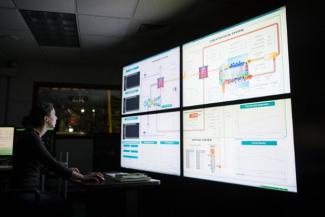For many, the term “hybrid energy technology” conjures images of gasoline/battery-powered cars. But in one particular NETL research facility, “hybrid energy technology” means innovative energy-producing power technology combinations that can achieve increased efficiency, flexibility, and reduced emissions while meeting America’s energy needs.
NETL’s Hybrid Performance (HyPer) facility was created to support U.S. Department of Energy efforts to research highly efficient power generation technologies that can reduce U.S. dependence on foreign sources of oil and other energy feedstocks. HyPer researchers are also focused on achieving the Administration’s goal of zero CO2 emissions from power generators by 2035.
Another “must do” on HyPer’s research checklist is creating an ability to provide the flexibility to accommodate intermittent power fluctuations associated with renewable power resources like wind and solar, leading to a more stable power grid.
According to NETL’s Nate Weiland, no single technology is capable of meeting the aggressive efficiency and flexibility targets. That’s why the hybrid performance project is focused on researching and testing system integration and control technologies that can help evolve hybrid energy production capabilities.
“For example, a combination of a high-temperature fuel cell and a gas turbine is a hybrid technology we have studied extensively through the use of numerical models and demonstration projects,” Weiland said.
A fuel cell uses the chemical energy of hydrogen or other fuels to cleanly and efficiently produce electricity. Work at NETL is now devoted toward scaling this technology so it can provide power for systems as large as a utility power station. A gas turbine is a combustion engine that can convert heat energy from natural gas or other fuels into mechanical energy that then drives a generator that produces electrical energy.
“The Hybrid Performance Project was initiated to make this complex integration effort work,” he said. “Since then, the project expanded to include support for other innovative energy technology combinations, as well as serving as a test bed for sensors and advanced control methods that can improve the performance of new and existing power plants.”
NETL’s HyPer facility, located in Morgantown, West Virginia, is the only one of its kind in the world and simulates expensive developing technologies, which, combined with specific hardware, comprises a “cyber-physical system” approach.
Randy Gemmen of NETL, said the HyPer cyber-physical system uses software to evaluate the dynamics of a fully integrated energy system when coupled with on-site physical components like heat exchangers, burners and compressors, a generator and a variable load bank. Newer additions will be integrated hydrogen generation, storage and use, and carbon capture for fossil-based hybrid systems to help reach 2035 zero carbon goals.
“The cyber-physical approach allows control strategies to be developed and tested before actual implementation of a technology, reducing risk associated with pilot-scale exploration and scale-up to commercial demonstrations,” he said. “It also provides opportunities for feedback from the pilot scale to materials development that can impact system performance.”
A variety of hybrid system operating conditions can be tested without risk to expensive system components like fuel cells. For example, in determining operating boundaries of a fuel cell-turbine hybrid system, preliminary tests would have destroyed hundreds of millions of dollars’ worth of fuel cells. However, the cyber-physical approach allows for replacement of the fuel cell in the system with a detailed model and physical replication of its output conditions in real time for realistic integration with other system components. This approach enables exploration of control methods that increase fuel composition flexibility, operating strategies to maintain safe component conditions, and a potential ten-fold increase in component life through simulations.
Weiland added that recent modifications allow the facility to explore a wider variety of integrated energy systems.
“We’ve recently added an internal combustion engine and fuel reformer to enable development of operation approaches for other hybrid systems prior to commercialization,” he said. “We’re also adding a more plug-and-play functionality that allows for a wider variety of integrated energy system testing.”
The HyPer experimental facility and modeling results are available for public research collaboration with universities, industry and other research institutions through a variety of cooperative programs and student or visiting scholar programs. More information about the program is contained in a newly released fact sheet.
NETL is a U.S. Department of Energy national laboratory that drives innovation and delivers technological solutions for an environmentally sustainable and prosperous energy future. By leveraging its world-class talent and research facilities, NETL is ensuring affordable, abundant and reliable energy that drives a robust economy and national security, while developing technologies to manage carbon across the full life cycle, enabling environmental sustainability for all Americans.




